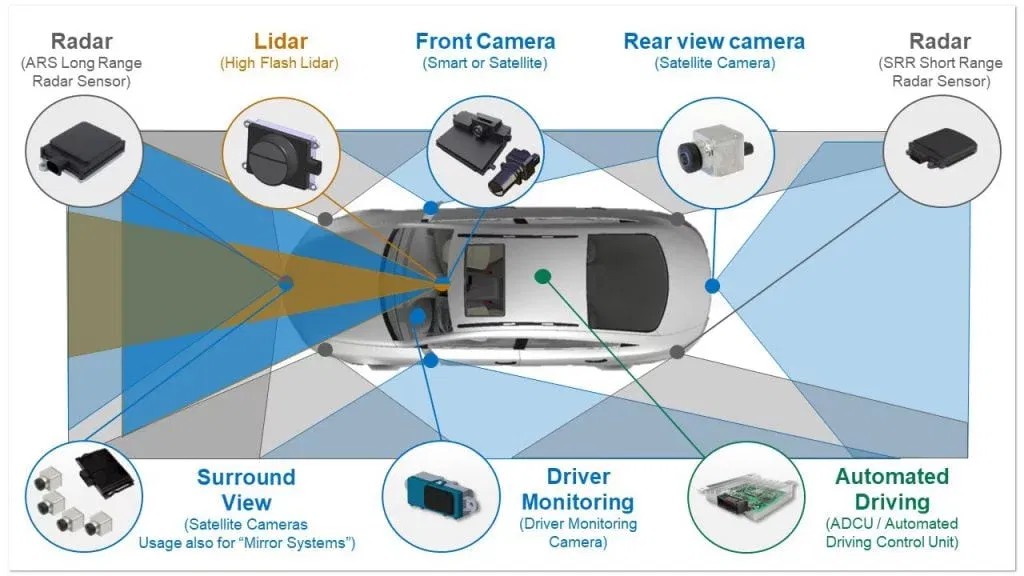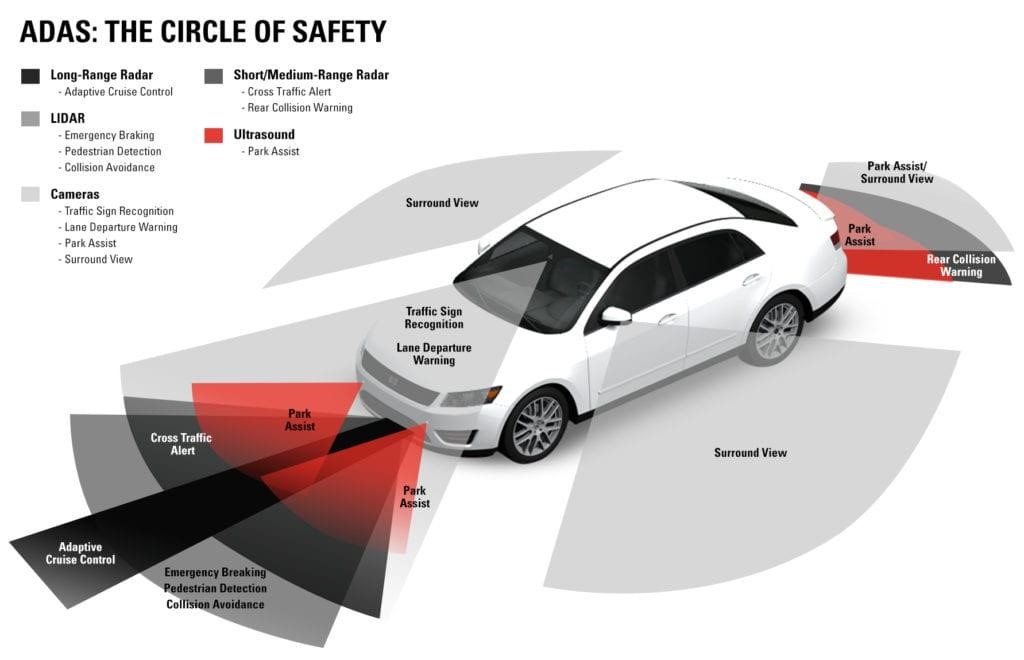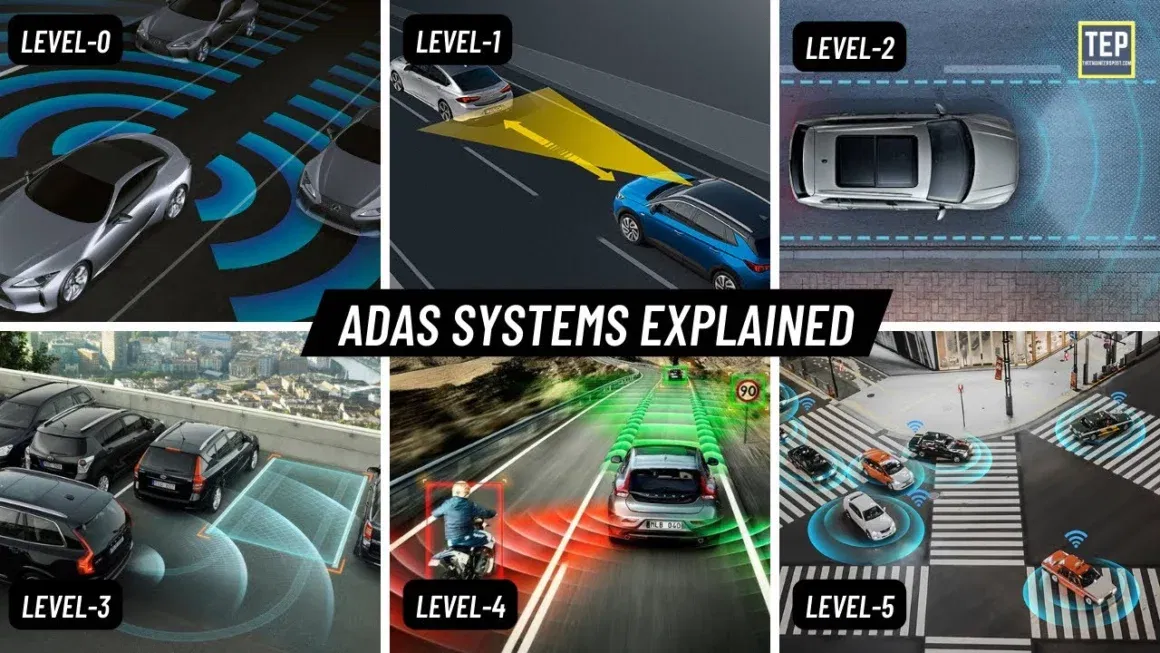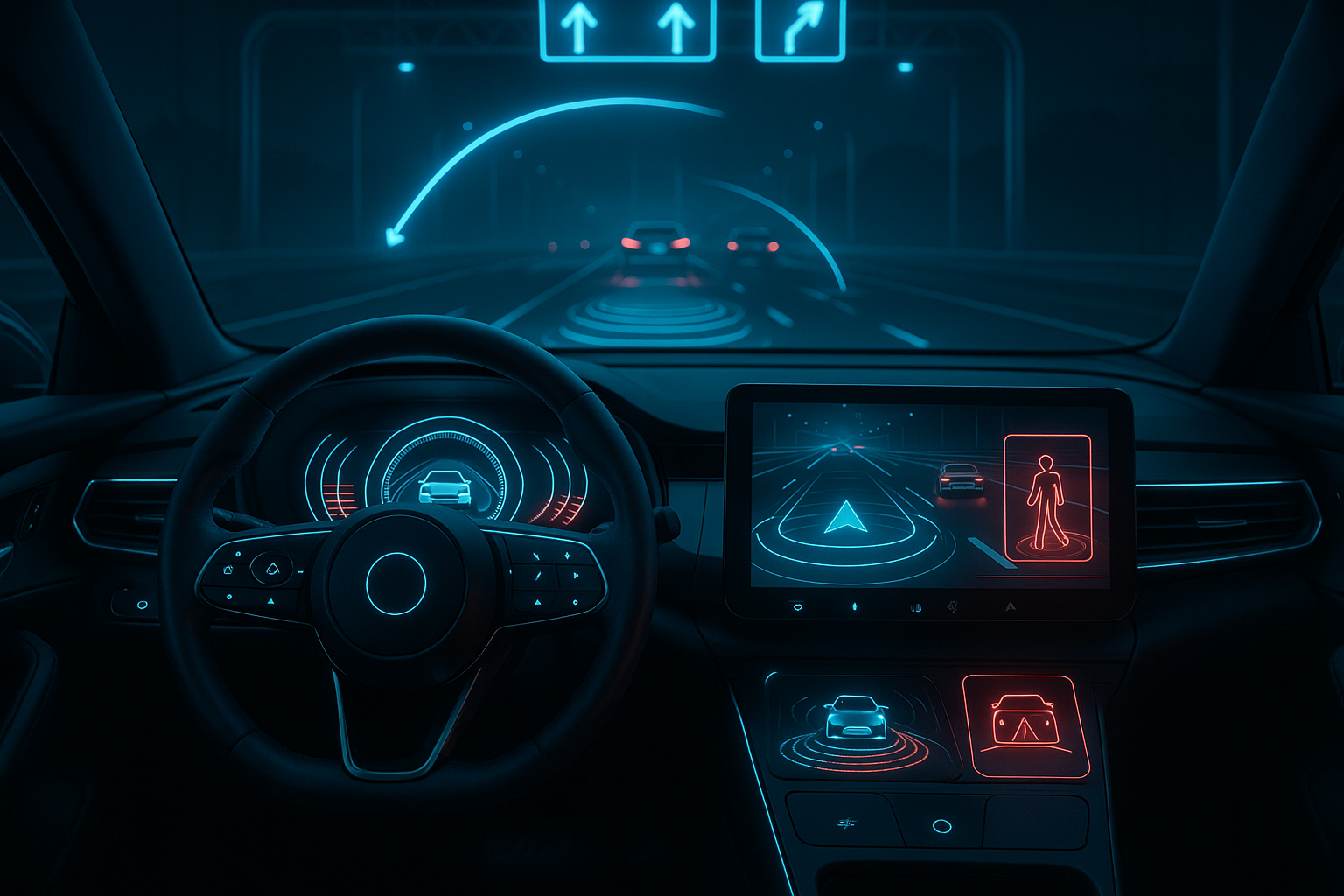That seemingly harmless parking lot scrape or minor rear-end nudge might look like just a cosmetic issue. But in today’s increasingly sophisticated vehicles, it could be a direct hit to your car’s “brain” – its Advanced Driver Assistance Systems (ADAS). These smart features, designed to make driving safer and easier, rely on a complex network of sensors that are often located in surprisingly vulnerable spots. This article dives into why that minor fender bender can lead to major technological headaches and repair bills, and what you, as a savvy car owner or buyer, need to know to protect yourself and your investment in futuristic automotive tech.
Table of Contents
What is ADAS and Why Is It Everywhere?
Advanced Driver Assistance Systems, or ADAS, are rapidly becoming standard in new vehicles, fundamentally changing how we interact with our cars. You might know them by names like adaptive cruise control, automatic emergency braking, lane-keeping assist, or blind-spot monitoring. These aren’t just fancy add-ons anymore; they are integral to modern vehicle safety and convenience, acting like an extra set of eyes (and sometimes reflexes) on the road.
The proliferation of ADAS is driven by a quest for enhanced safety, with regulatory bodies and safety rating organizations like the NHTSA (National Highway Traffic Safety Administration) and IIHS (Insurance Institute for Highway Safety) increasingly rewarding vehicles equipped with these technologies. For car buyers, especially those interested in affordable yet futuristic or smart automotive solutions, ADAS offers a taste of autonomous driving capabilities and a significant safety net. EV enthusiasts also find these systems align well with the high-tech nature of electric vehicles.
The Unseen Danger: How Fender Benders Impact ADAS
The critical components of ADAS – its sensors – are often located in areas prone to damage even in low-speed collisions, such as bumpers, grilles, windshields, and side mirrors. These sensors, including cameras, radar, lidar, and ultrasonic units, are the “eyes and ears” of your car’s ADAS brain, the Electronic Control Unit (ECU) that processes all the incoming data.
A minor impact, a dented bumper, or even a seemingly insignificant crack in the windshield can knock these sensitive instruments out of alignment, damage their internal workings, or obstruct their view. When a sensor is compromised, it feeds inaccurate information to the ADAS brain, or no information at all. This can lead to system malfunctions or complete failure, turning a helpful safety feature into a potential hazard or simply a very expensive, non-functional piece of tech.
Common ADAS Features & Their Vulnerable Sensors
Understanding which features rely on which sensors can help you appreciate the potential impact of even minor damage.
| ADAS Feature | Key Sensors Used | Common Sensor Locations | Vulnerability in Minor Impact |
| Automatic Emergency Braking (AEB) | Radar, Camera | Front Grille/Bumper, Windshield (behind rearview mirror) | Misalignment, physical damage, obstruction |
| Adaptive Cruise Control (ACC) | Radar, Camera | Front Grille/Bumper, Windshield | Misalignment, physical damage from front impacts |
| Lane Keeping Assist (LKA) | Camera | Windshield (behind rearview mirror) | Windshield cracks, camera misalignment |
| Blind Spot Monitoring (BSM) | Radar, Ultrasonic | Rear Bumper Corners, Side Mirrors | Bumper scuffs/damage, mirror damage |
| Rear Cross-Traffic Alert | Radar, Ultrasonic | Rear Bumper Corners | Damage from backing incidents, bumper impacts |
| Parking Assist / 360° Camera | Cameras, Ultrasonic | Front/Rear Bumpers, Side Mirrors, Grille | Scratches on lenses, sensor dislodgement, wiring issues |
The Price of Precision: Why ADAS Repairs Are So Expensive
Repairing or replacing damaged ADAS components and ensuring they function correctly often involves a costly and complex process called calibration. Unlike a simple bumper replacement of the past, fixing a modern car post-collision requires specialized equipment, meticulously clean environments, and highly trained technicians.

Here’s why the bills can stack up:
- Sensor Replacement: The sensors themselves can be expensive, ranging from a few hundred to over a thousand dollars each.
- Calibration: After a sensor is replaced, or even if a bumper is removed and reinstalled, the ADAS system usually needs to be recalibrated. This ensures the sensors are perfectly aligned and “seeing” the world correctly. Calibration can be static (done in the workshop with targets) or dynamic (requiring a road test with specific parameters), and it adds significant labor costs.
- Windshield Woes: A simple windshield replacement is no longer simple if your car has a forward-facing camera for ADAS. The new windshield must be OEM-quality or equivalent, and the camera must be recalibrated, often adding hundreds of dollars to the job.
- Specialized Labor: Not all body shops are equipped or trained to handle ADAS repairs and calibrations. Those that are often charge a premium for their expertise and investment in technology.
“Many consumers are shocked when a $500 bumper scuff turns into a $3,000 repair bill because of underlying ADAS sensor damage and calibration needs,” notes Sarah Chen, an auto insurance industry analyst. “It’s a new reality of car ownership.”

ADAS Repair Cost Snapshot After Minor Impacts
These are general estimates and can vary widely based on car make/model, location, and the specific damage incurred.
| Incident Type | Potentially Affected ADAS Components | Estimated Cost Range ($USD) |
| Minor Front Bumper Damage (scrape, small dent) | Radar sensor, Camera (if grille-mounted), Parking sensors | $800 – $2,500+ |
| Minor Rear Bumper Damage | Blind Spot Monitors, Rear Cross-Traffic Alert sensors, Parking sensors | $600 – $2,000+ |
| Cracked Windshield (with ADAS camera) | Forward-facing Camera | $500 – $1,500+ (for replacement & calibration) |
| Side Mirror Damaged | Blind Spot Monitor sensor (if mirror-housed), 360° Camera | $300 – $1,000+ per mirror |
When “Smart” Tech Fails: The Risks of Damaged ADAS
A malfunctioning ADAS, often a result of unaddressed minor damage, can create dangerous situations on the road. These “smart” systems, designed to enhance safety, can become unpredictable or unreliable if their sensory input is flawed.
Imagine these scenarios:
- Phantom Braking: Your Automatic Emergency Braking system suddenly slams on the brakes for no apparent reason because a misaligned radar sensor misinterprets an overhead sign or a harmless object.
- Lane Departure Errors: Your Lane Keeping Assist might aggressively steer you towards the lane marker or fail to detect lane drift if the camera is out of focus or improperly calibrated.
- Blind Spot Blindness: Your Blind Spot Monitor might fail to alert you to a vehicle in the adjacent lane, increasing the risk of a collision during a lane change.
Relying on a compromised ADAS is like trusting a co-pilot who has incorrect information. This is particularly crucial for drivers of AI-powered vehicles or those who have become accustomed to these aids.
Safety Compromised: The Irony of Faulty Driver Aids
The very systems designed to protect you can become liabilities if they are not functioning as intended due to post-accident miscalibration or damage. This presents a significant irony: features that contribute to a car’s 5-star safety rating could, if compromised, actually degrade real-world safety.
If ADAS features are not working correctly, the vehicle is essentially not performing to its designed safety specification. This could have implications not just for driver and passenger safety, but potentially even for liability in the event of a subsequent accident caused by ADAS malfunction.
Beyond the Dent: Hidden Damage to Your Car’s Senses
It’s crucial for car owners to understand that the visible damage after a fender bender often doesn’t tell the whole story, especially when it comes to your car’s sophisticated ADAS “senses.” A bumper cover might pop back into place or show only minor scuffs, but the radar unit mounted behind it could be cracked, dislodged, or have its bracket bent by mere millimeters—enough to throw off its precise calculations.
Similarly, a tiny chip in the windshield might seem insignificant, but if it’s in the field of view of an ADAS camera, or if the windshield is later replaced without proper camera recalibration, features like lane assist and traffic sign recognition can be severely impaired. These sensors are the delicate nerve endings of your car’s ADAS brain; treat any impact near them with suspicion.
Navigating the Aftermath: ADAS Repairs and Insurance Woes
After any collision, no matter how minor, it’s vital to specifically inquire about ADAS inspection and calibration when seeking repairs. Don’t assume the body shop will automatically handle it correctly.
Here are some tips:
- Choose Certified Repair Shops: Look for shops certified by your vehicle’s manufacturer or by reputable third-party organizations (like I-CAR) that specialize in ADAS repairs.
- Ask Questions: Specifically ask if they have the equipment and training to calibrate your vehicle’s specific ADAS features. Request a printout or digital confirmation of successful calibration.
- Inform Your Insurer: When filing a claim, mention that your vehicle has ADAS and that you’re concerned about potential sensor damage and calibration needs. Most comprehensive insurance policies should cover necessary ADAS repairs and calibrations, but it’s wise to confirm.
- OEM Parts: For critical ADAS components, especially cameras and sensors, using Original Equipment Manufacturer (OEM) parts is often recommended to ensure compatibility and performance.
“The days of ‘buffing it out’ are over for many parts of the car,” says Mark Jefferson, a veteran auto repair technician. “We now need to think like IT specialists as much as mechanics when dealing with collision repair.”

Expert Insights: The Auto Industry on ADAS Vulnerabilities
Industry experts are increasingly vocal about the challenges and complexities surrounding ADAS repairs.
Dr. Anya Sharma, an automotive technology researcher, states, “While ADAS significantly enhances safety potential, the industry is still grappling with standardizing repair procedures and ensuring technician proficiency across the board. The sensitivity of these systems to physical insult is a major engineering and service challenge.”
From the insurance perspective, “We’re seeing a clear trend of increased average repair costs, partly driven by ADAS complexity,” explains analyst Sarah Chen. “This may eventually impact premiums if the frequency and cost of these specialized repairs continue to rise. Consumer education on this topic is key.”
Master technician Luis Hernandez adds, “It’s not just about replacing a part anymore. It’s about restoring a complex, interconnected system to factory specification. A degree of misalignment that would have been unnoticeable on an older car can render an ADAS feature useless or even dangerous on a new one.”
Challenges on the Horizon for Owners and a Tech-Driven Industry
The widespread adoption of ADAS brings several challenges that both car owners and the automotive industry must address. These include:
- Rising Repair Costs & Insurance Premiums: As highlighted, the cost to repair even minor damage is increasing, potentially leading to higher insurance deductibles or premiums over time.
- Technician Skill Gap: There’s a growing need for technicians with specialized training in ADAS diagnostics and calibration, and the training infrastructure is still catching up.
- Right to Repair Concerns: Independent repair shops may face challenges accessing OEM repair procedures, diagnostic tools, and software needed for ADAS calibration, potentially limiting consumer choice.
- Awareness Gap: Many consumers are still unaware of the sensitivity of ADAS components and the necessity of calibration after seemingly minor incidents.
For those seeking affordable automotive solutions, these potential downstream costs are an important consideration when purchasing a new or used vehicle equipped with advanced tech.
The Future of ADAS: Towards More Resilient Systems?
Looking ahead, the automotive industry is working on making ADAS technology more robust and potentially easier and cheaper to service. This is a critical step for the long-term viability and affordability of these safety systems.
Potential advancements include:
- More Protected Sensor Placement: Engineers are exploring ways to better shield sensors without compromising their functionality.
- Self-Calibrating Systems: Some newer systems are designed with limited self-calibration capabilities, reducing the need for workshop intervention for minor adjustments. However, significant impacts will still likely require professional attention.
- Improved Diagnostics: Better onboard diagnostics could help pinpoint ADAS issues more quickly and accurately.
- Modular Sensor Design: Designs that allow for easier replacement of damaged sensor components rather than entire expensive units could lower repair costs.
The goal is to balance the incredible life-saving potential of ADAS with the practical realities of vehicle ownership, including occasional bumps and scrapes.

Conclusion: Protecting Your Car’s High-Tech Brain (And Your Wallet)
That “minor” fender bender now carries implications far beyond a simple cosmetic fix; it can directly impact the sophisticated electronic “brain” and “senses” of your modern vehicle. As cars evolve into smarter, more aware machines, owners must also become more aware of the delicate technology nestled within their bumpers, windshields, and mirrors.
Being informed about ADAS, its vulnerabilities, and the importance of proper repair and calibration is your best defense against unexpected massive bills and, more importantly, against compromised safety systems. Don’t let a small impact lead to a big problem. When your smart car takes a hit, ensure its brain gets the expert care it needs to keep you safe on the road to the future.
FAQs: Your ADAS Damage Questions Answered
- How do I know if my ADAS is damaged after a minor accident?
- Look for warning lights on your dashboard related to ADAS features (e.g., “ACC unavailable,” “Check AEB system”). You might also notice features behaving erratically (e.g., lane assist not working, cruise control issues). However, some damage might not trigger an immediate warning, so it’s best to have it checked by a qualified shop if you suspect an impact near sensor locations, especially if the feature was working fine before the incident.
- Can I just turn off a faulty ADAS feature?
- Most vehicles allow you to temporarily disable certain ADAS features through the infotainment settings. While this might prevent erratic behavior, it also means you lose the safety benefit of that feature. It’s not a long-term solution; proper repair is essential.
- Will my auto insurance cover ADAS calibration and sensor replacement?
- Generally, yes. If the damage is part of a covered claim (like a collision), the necessary ADAS repairs, including sensor replacement and calibration, should be covered by your comprehensive or collision insurance, subject to your deductible. Always confirm with your insurer.
- Are aftermarket ADAS sensors or windshields as good as OEM?
- This is a contentious area. While some high-quality aftermarket options exist, OEM (Original Equipment Manufacturer) parts are generally recommended for ADAS components, especially cameras and sensors, to ensure perfect compatibility and performance. Using non-OEM parts can sometimes lead to calibration issues or system malfunctions. Consult with a trusted, certified repair shop.
- How can I minimize ADAS repair costs if an accident happens?
- While you can’t always avoid accidents, ensure you take your car to a repair shop that is transparent about ADAS repair needs upfront. Get multiple quotes if possible, specifically asking about ADAS diagnostics and calibration. Being an informed consumer can help prevent unnecessary charges.
- Do Electric Vehicles (EVs) have more ADAS vulnerabilities?
- EVs often feature advanced ADAS as standard, aligning with their high-tech image. The vulnerabilities are generally the same as any other vehicle with similar ADAS technology – it’s about the sensors and their placement, not the powertrain. However, because EVs are often tech-laden, the prevalence of ADAS might be higher, meaning more EV owners will encounter these potential repair issues.
